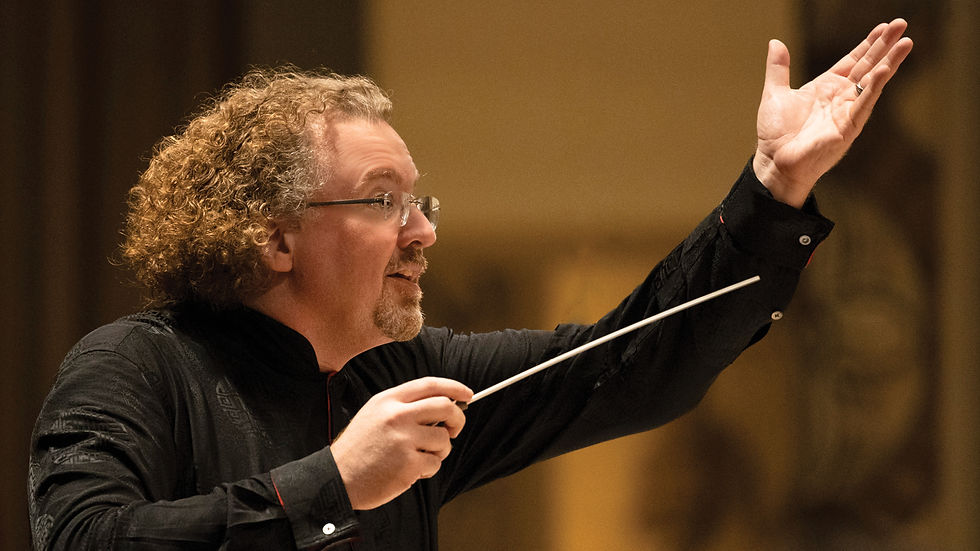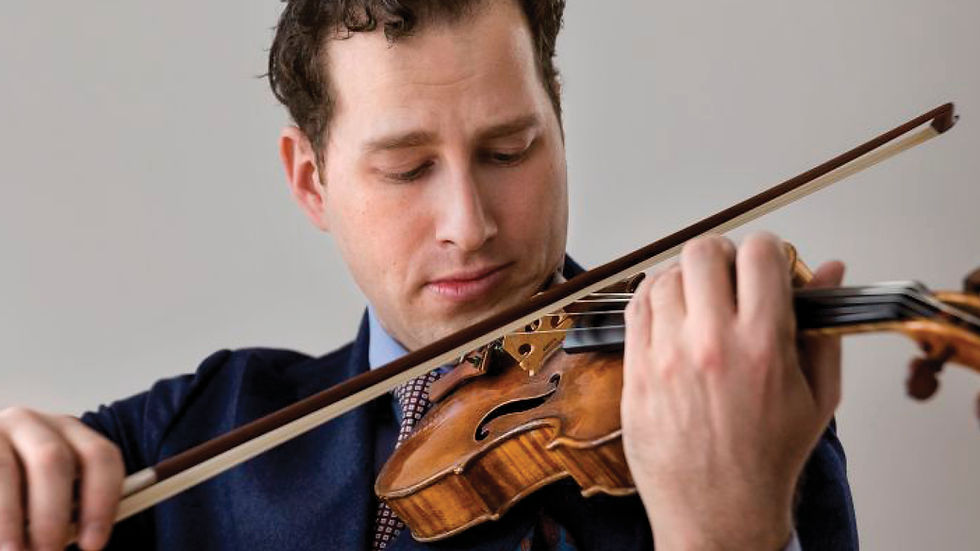Program Notes: Beethoven's Ninth
- SLSO
- Feb 2, 2020
- 7 min read
Updated: Apr 29, 2020
Friday, February 7, 2020, at 8:00PM
Saturday, February 8, 2020, at 8:00PM
Sunday, February 9, 2020, at 3:00PM
Stéphane Denève, conductor Ellie Dehn, soprano
Jennifer Johnson Cano, mezzo-soprano
Issachah Savage, tenor
Morris Robinson, bass
St. Louis Symphony Chorus | Amy Kaiser, director
KEVIN PUTS Silent Night Elegy BEETHOVEN Symphony No. 9 in D minor, op. 125
We gather into groups, sorted by class, race, religion, politics. Groups resist and exclude. Wars are fought, millions die.
The composers on this program argue for another path.
In the opera Silent Night, enemies meet in a ceasefire during World War I. German, French, English, and Scottish troops talk and come to know each other, at least a little. And, says composer Kevin Puts, “once your sworn enemy ceases to be faceless, war becomes far less possible.”
Beethoven, a passionate progressive, resisted divisions in society. His Ninth Symphony sets a poem that links joy with friendship, with kinship: “All men shall become brothers/Wherever [joy’s] gentle wings hover.”
Is it utopian to imagine that music might unite? Millions were killed even after Christmas carols were sung together during the wartime ceasefire. And although Beethoven’s music has been used to bring people together, it has also been used to justify great evil.
Perhaps it is enough to say this: Puts and Beethoven—seeing hatred and division—responded with stories of optimism and generosity. May we also do the same.
KEVIN PUTS
Born January 3, 1972, St. Louis, Missouri
Silent Night Elegy
Born in St. Louis, Kevin Puts is one of America’s most performed composers. With four symphonies and more than twenty chamber works to his name, his goal has always been emotional directness: “I want audiences to be held in the moment, and be taken to the next moment. If that’s not happening, I feel like I’m falling short.”
Silent Night, written in 2011, is Puts’ first opera. It adapts Joyeux Noël, the award-winning 2005 film that tells the story of the spontaneous cease-fires that took place along the Western Front on the first Christmas Eve of World War I.
The opera premiered in 2011, and has since traveled around the world, garnering popular acclaim and winning the composer the Pulitzer Prize for Music. Puts and librettist Mark Campbell went on to collaborate on two more operas: The Manchurian Candidate and Elizabeth Cree.
Since the opera’s premiere, Puts says that he has been regularly asked for a purely orchestral work based on the opera’s music. He was inspired by the success of Benjamin Britten's Four Sea Interludes from Peter Grimes, but he felt “that a single-movement ‘essay’— rather than a suite of separate movements—would work better for my purposes.”
Silent Night Elegy more or less follows the narrative of the opera itself. The five sections are performed without a break. Puts has written the following description of each section:
Introduction: An introduction, featuring solo horn and solo cello, introduces the primary thematic material of the opera. This is followed by a contrapuntal layering of the battle songs sung by the three armies (French, German, and Scottish) in the opera’s prologue, anchored by a military snare drum.
The Battle: Music from the prologue leads directly to the cataclysmic battle scene which occurs near the beginning of Act I.
Aftermath and Burial: A sense of confusion, sadness, and disarray follow until a lonely solo flute, accompanied by the harp, emerges from the haze and introduces the music of the Act II burial scene. In this scene—which culminates in a bagpipe melody—the soldiers have agreed to extend the cease-fire to allow time to bury the bodies strewn about in No-man’s Land.
The Generals’ Rage: The generals of all three armies receive word of the unofficial celebrations. They are incensed and order the soldiers transferred to areas on the front where the fighting is most fierce.
Sleep: In our first discussion about the opera, Mark Campbell mentioned a possible scene in which all three armies drift off to sleep on the evening after the great battle, singing in their three languages about home as snow gradually begins to fall. This became a chorus in Act I, and the Elegy closes with this prayerful music.
First performance: October 25, 2018, Cristian Măcelaru conducting the San Francisco Symphony
First SLSO performance: This weekend’s concerts
Scoring: 3 flutes (2nd and 3rd doubling piccolo), 2 oboes, English horn, 3 clarinets (3rd doubling bass clarinet and E-flat clarinet), 2 bassoons, contrabassoon, 4 horns, 3 trumpets, 3 trombones, tuba, timpani, anvil, bass drum, brake drum, Chinese cymbals, claves, cowbell, crash cymbal, crotales, glockenspiel, snare drum, suspended cymbal, tam tam, triangle, tubular bells, vibraphone, wood block, xylophone, harp, piano, strings
Performance time: Approximately 20 minutes

LUDWIG VAN BEETHOVEN
Born December 16, 1770, Bonn, Germany
Died March 26, 1827, Vienna, Austria
Symphony No. 9 in D minor, op. 125
A cramped city apartment is strewn with clothes, plates of rotting food. At a table sits a short, stocky man, hunched over a mess of papers.
Although 52, Beethoven looks much older. He is in constant physical and emotional pain, and rarely appears in public, self-conscious about his total deafness.
Against all odds he still believes in the power of his music. Beethoven leans over a copy of the popular ode, “To joy,” by Friedrich Schiller. He is at work on a new symphony, a work so massive, so experimental, that it is without precedent.
Beethoven doesn’t know it yet, but this symphony will be his final public success. It may baffle generations of listeners, but a cult following will grow until the music of the Ninth criss-crosses the globe, used for political rallies and TV shows, used to unite as well as to divide.
Schiller
Thirty years prior, when a young Beethoven first read this ode, Friedrich Schiller was Germany’s most popular writer, a free-spirited libertine who generated rock-star adulation.
An “ode” is a poem—often sung—that deals with a thing or person or idea. Schiller’s ode, An die Freude (“To joy” or “On joy”), was in praise of “joy.”
The language of his poem is intoxicating, almost erotic—Schiller himself later judged it over-the-top. But the ode appealed to the optimistic mood of pre-French Revolution Europe, and was a hit, sung over beers at parties across Germany.
The young Beethoven, loving “liberty above all things,” may have been drawn to the poem’s politics. In the ode, freedom and joy are linked: joy provides a path to moral goodness for all of humanity. Schiller’s first version of the poem called for “rescue from the chains of tyrants.”
At age 22, Beethoven sketched a setting of An die Freude for voice and piano. The setting lay, unfinished, but Beethoven never forgot the power of Schiller’s words.
Composition
By 1822, Beethoven was finding his way out of a long creative drought. Life had been difficult for this middle-aged man, but he had recently completed works that redefined their genres: an epic mass setting and a set of piano variations of dizzying complexity.
So, when a concrete financial offer came along, Beethoven was primed for an artistic challenge. He had been thinking of a symphony with choir for several years,
but it was an almost unsolvable, nerve-wracking problem to solve. Schiller’s An die Freude was the missing piece of the puzzle.
Why did Beethoven return to Schiller’s ode now, 30 years after he had first read it? By 1822, the ideals of the French Revolution had been trampled by a megalomaniac. Europe had been seized by bloody wars. Austria’s monarch had turned ruthless, clamping down on liberals, artists, journalists. The ode’s optimism had soured.
Perhaps this moment—repressive, divided—was perfect for Beethoven to launch a defense of progressive ideals in the most public forum he knew: the symphony.
The First Three Movements
The first three instrumental movements of the Ninth build on experiments from Beethoven’s previous symphonies: expanding horizons, testing players, building complexity.
Warlike music dominates the first movement. The opening is radical—vacant, trembling—but soon the music turns furious, forceful, savage. Near the end of the movement, a march approaches. There is no triumph—the tone is dark, the tread heavy: heroic music of Beethoven’s past, gone to seed.
The second movement is no fun-loving scherzo. Beethoven has us firmly in the grip of a major key, but the fun-loving rough-and-tumble of his earlier symphonic scherzos has taken on deep shadows. The orchestra dances perilously close to a fire.
The third movement blooms like a beautiful flower. Two melodies are woven together, arm in arm. Each is simpler, more hummable than earlier Beethoven tunes, and each grows throughout the movement, blossoming in richness and complexity.
The Finale
A grinding dissonance jolts. Onstage we see a choir, four soloists, but they don’t sing yet. Instead, Beethoven gives us the voices of the double basses, who launch into an operatic recitative.
Their job: to stand in judgment of music from the symphony’s first three movements. The first movement: rejected. The second: rejected. The third: rejected. Beethoven is turning his back on the music of his own symphony.
But why? Is Beethoven saying that instrumental music is insufficient at this important moment? Or that this music—his music—is no longer relevant? That we should look to the future, rather than to the past?
The following “Ode to Joy” is thrilling and confusing: asking more questions than it answers. It is part-opera, part-theme and variations, part-cantata, part-political speech, part-philosophical rant, part-celebratory jam.
There are triumphs: the key of D major triumphs over D minor; voices triumph over instruments; joy triumphs over division.
There are impossibilities: The choir sings notes beyond what was considered possible at the time. The orchestra attempts music that would have been unplayable by the mix of amateurs and professionals at the premiere.
There are contradictions: God plays an important role in proceedings, even though Beethoven rejected organized religion. Brotherhood plays a role, even though Beethoven had very few close friends.
Music historian Richard Taruskin puts it like this: Beethoven’s Ninth Symphony “is at once incomprehensible and irresistible…at once awesome and naïve.”
The Ninth Symphony’s premiere must have sounded catastrophic. Handwritten instrumental parts were messy and error-ridden, the music was impossible for a mix of amateurs and professionals, and the two rehearsals were scarcely enough, especially with Beethoven—at this point completely deaf—conducting.
Some were thrilled, some baffled. The nineteen-year-old Franz Schubert wrote in his diary that “the eccentricity which confuses the tragic with the comic, the agreeable with the repulsive, heroism with howlings, and the holiest with harlequinades.”
First performance: May 7, 1824, at the Theater am Kärntnertor in Vienna, Michael Umlauf conducting with Henriette Sontag, Caroline Unger, Anton Haizinger, and Joseph Seipelt as soloists
First SLSO performance: December 21, 1928, Emil Oberhoffer conducting with Helen Traubel, Viola Silva, Laurence Wolfe, and Jerome Swinford as soloists, The Apollo-Morning Choral Clubs as chorus
Most recent SLSO performance: October 11, 2015, Markus Stenz conducting with Angela Meade, Theodora Hanslowe, Thomas Cooley, and Eric Owens as soloists
Scoring: piccolo, 2 flutes, 2 oboes, 2 clarinets, 2 bassoons, contrabassoon, 4 horns, 2 trumpets, 3 trombones, timpani, bass drum, cymbals, triangle, strings; soprano, alto, tenor, and bass soloists; chorus
Performance time: Approximately 1 hour and 5 minutes
Program Notes by Tim Munro, the SLSO's Creative Partner.





Comments